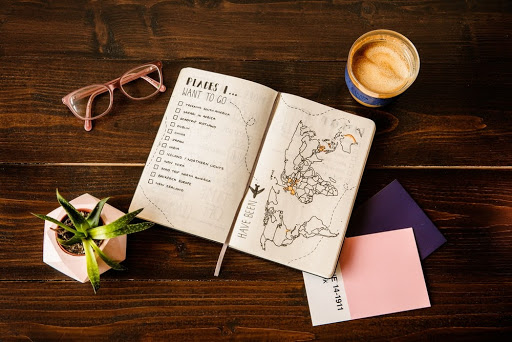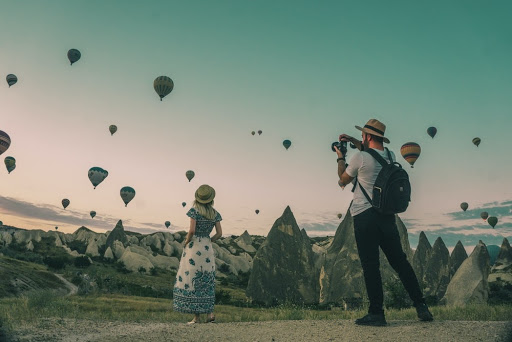Finding Life After Kicking the Bucket List
Photo: illustration of a list of places to go | Bucket List
Have you ever felt a sense of urgency to see it all? In conversations of travel, are you guilty of saying, “been there, done that”? If yes, you may have fallen victim to the bucket list.
As life slowly returns to a new version of normal, it is clear that people are anxious to get back into travelling. It appears as though everyone has itchy feet after a year plus of restrictions and limitations. In quarantine, people have had time to fantasize about what they want to see and do when they can finally travel again. There is a newfound angst about ensuring we are living life to the fullest and many of us itemize the things we want to do and see in the form of a bucket list.
The phrase gained popularity from the 2007 movie aptly named The Bucket List, about two terminally ill men with six months to live who make a list about all of the things they want to do before they die. While the trend isn’t necessarily recent, it has certainly taken on a whole new meaning as we enter the post pandemic era.
So, why do we create bucket lists anyways? Associated with goal making and the organization of ideas, a travel bucket list often consists of places you have heard about through your social circle or the media. This brings me to my first point about why you shouldn’t create one: they are often constructed out of obligation, not pleasure.
Bonus tip: ensure you do some research to decipher whether or not you have initial interest in seeing or doing something specific, but be sure to leave an element of surprise so you can revel in anticipation! Sometimes the anonymity or unfamiliarity of a landmark can spark unexpected intrigue, so leave room for that as well.
Those tourist traps are giving you FOMO
In his book “The Ethics of Sightseeing”, Dean MacCannell says “(The collective “desire for travel”) can be something one does simply as a marker of social station. ‘The bucket list’ fad reflects and amplifies socially constructed desire.” To put it simply, items on a bucket list are often little beyond an antidote to “FOMO” (fear of missing out). It may seem obvious but you should consider if the items on your list are actually places you have personal interest in visiting. I’ll admit that I have seen things that I was indifferent about, but went and saw them anyway as that was a “must do”. When I look back now, this resulted in an experience that wasn’t particularly meaningful or memorable. From this standpoint, it is easy to wonder how many people within the crowds of hundreds swarming famous monuments are actually there out of personal interest.
Photo: Man taking a photo of woman | Hot air balloons in the background
“I haven’t been everywhere but it’s on my list.”
The Problem with Quantity over Quality - Another issue with the bucket list fad is that the list is often about quantity over quality. This mindset is particularly evident in a recent concept that has surfaced called “revenge travel”. The term describes the rise in post pandemic tourism. When we look at quantity (a.k.a. visiting as many places as possible) over quality, we ignore the fact that this isn’t the behaviour of a conscientious tourist. Daniel Noll, tourism development specialist with Uncornered Market says, “(The bucket list) has replaced the depth of qualitative connection in travel with the breadth of doing as many things as possible and the pursuit of the ‘epic’, in the form of an Instagrammable shot.”
Countless studies and research have shown that overdoing it on photo taking does little to aid in our memory of and feelings in the moment (see this TED article for more information on this). Noll also points out the impact bucket lists have on our personal wellbeing, “The bucket list travel mentality has become a bit of a display...it places on us a pressure to do more and to evaluate our ‘success’ by the number of items crossed off the bucket list, which distorts our expectations and our happiness baseline.”
Ditching Expectations and Expanding Your Horizons
Bucket lists can impede on the quality of an experience through their restricted, commercialized nature and high expectations for the places to be seen. When we think of bucket lists, we often think of the big things such as seeing the northern lights or visiting the Eiffel Tower. While visiting a particular landmark as the main goal may be fine, it can come with a form of tunnel vision that builds expectations leading up to that moment. This can skew perspective and make you miss out on the hidden gems along the way. Avner Ofer, a fine art travel photographer and self described “immersive” traveller, spent a year and a half backpacking in the mid nineties, when he decided to ditch the bucket list and found he had more to show for it. He arrived in Panama’s dense wilderness with no plans and bumped into an indigenous child who guided him to a local village. As the first tourist ever to visit the village, he spent four remarkable days as the guest of a tribe. He says, “For me, travel is about connecting with people and cultures - not about seeing a famous spot and leaving.”
Come to your experience with an open mindedness and enough flexibility to enjoy the little things along the way. Real life isn’t staged and you shouldn’t expect your trip to be either. Sometimes, the simplest of moments and connections are more impactful than the main event.
Bucket List Alternatives
Maybe the solution lies in taking the bucket list approach and using it to make your travels meaningful for the places you are visiting. Instead of the singular focus on what you want to see, think about an action you want to take that will benefit the communities you are visiting. Be actively engaged in creating (or co-creating) your experience - tune out the background noise of what the media or your social circle is telling you to see or do. “How to Live a Good Life” author Jonathan Fields suggests making a list of “One”, which he defines as “a single, meaningful action you’re going to take..to move you one step closer to a single, deeply meaningful quest.”
No matter which approach you take, remember that your travel choices have the potential to promote self growth and the betterment of the people and places you visit. That always holds more value than any checklist.

For more information on Transformational Travel and how it could be implemented into your travels or business, please feel free to reach out to me.
Written by Claire Burt
Vegan Vacations is 100% vegan owned and operated. As a Vegan Travel Agent supporting vegan travellers all across North America, we make Plant-based vacations a reality.



